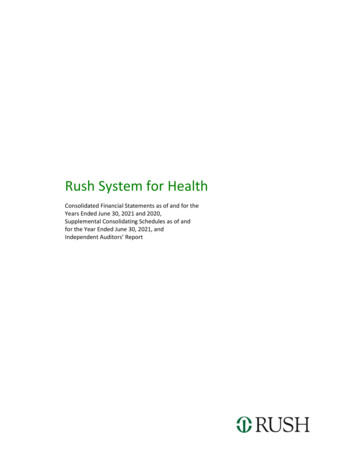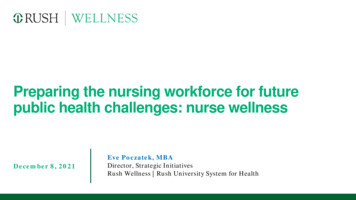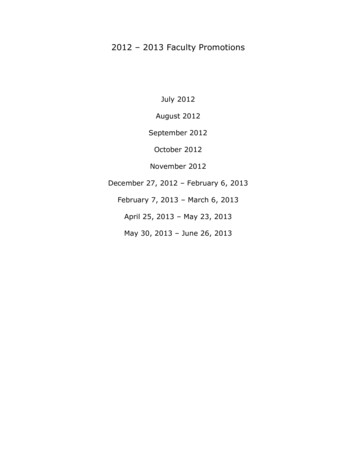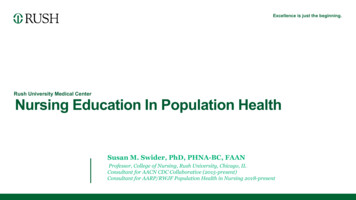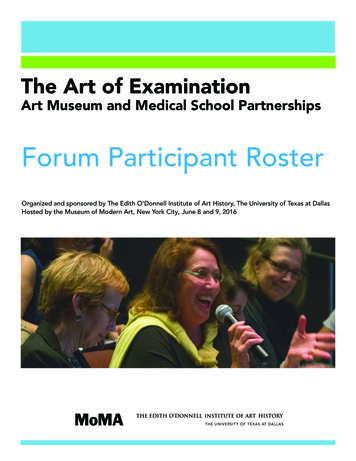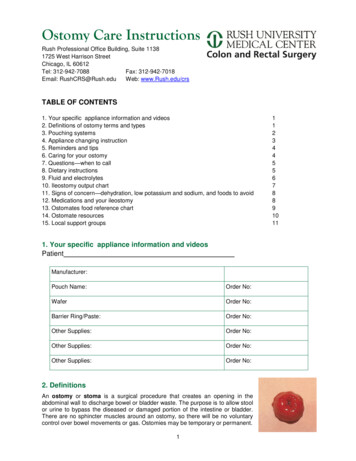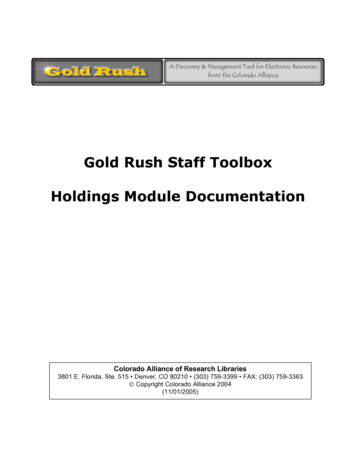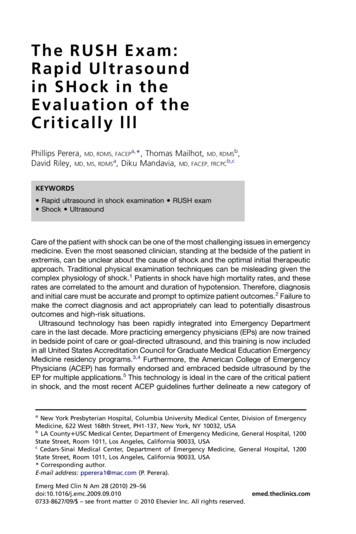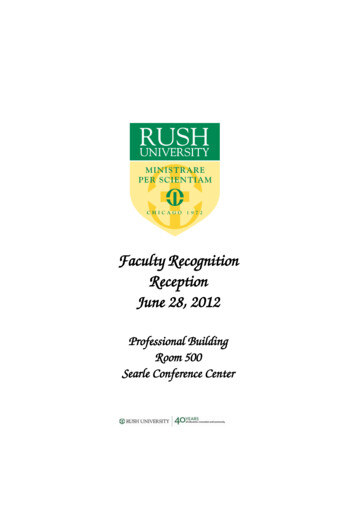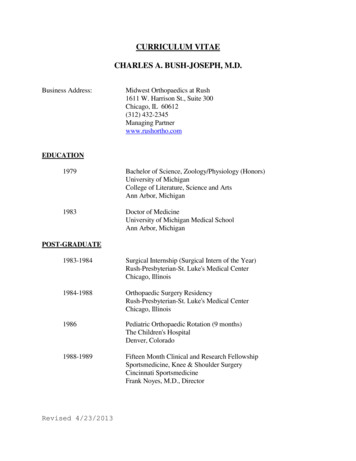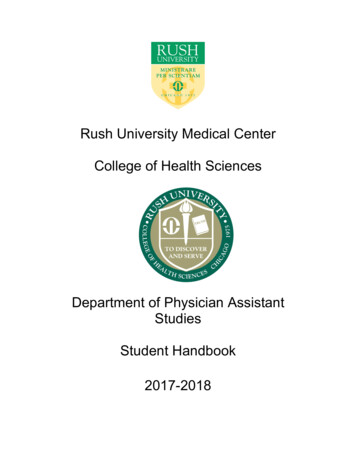
Transcription
Rush University Medical CenterCollege of Health SciencesDepartment of Physician AssistantStudiesStudent Handbook2017-2018
PA Program HandbookPage 2 of 65TABLE OF CONTENTSINTRODUCTION . 4BACKGROUND ON THE PA PROFESSION . 4RUSH MISSION, VISION, AND GOALS STATEMENTS . 4INSTITUTIONAL AND PROGRAM ACCREDITATION . 6GENERAL PROGRAM INFORMATION . 7PROGRAM CURRICULUM . 7PA Curriculum Sequence . 8PA Curriculum Sequence . 9Course Descriptions . 10GRADUATION REQUIREMENTS. 20ESTIMATE OF PROGRAM COSTS . 20PA Program Scholarships . 20RUSH PA PROGRAM PERFORMANCE ON THE NCCPA CERTIFICATION EXAMINATION . 21PA PROGRAM PERFORMANCE ON GOALS . 21PA PROGRAM FACULTY AND STAFF . 23PA PROGRAM POLICIES . 24ACADEMIC CALENDAR . 24ACADEMIC PERFORMANCE – STANDARDS AND PROGRESSION IN THE PROGRAM . 24ACADEMIC CONCERN AND PROBATION . 27ADVANCED ACADEMIC STANDING . 28ADVISING . 29ATTENDANCE . 29CLASS AND CLINICAL HOURS . 30CLASS OFFICERS . 30CLINICAL ROTATION ASSIGNMENTS . 31COMMUNITY SERVICE . 31COPYRIGHT AND USE OF MATERIALS . 32COURSE EVALUATION PROCEDURES . 32COURSE SEQUENCING AND DECELERATION . 32COURSE SYLLABUS AND OTHER LEARNING MATERIALS . 32CUMULATIVE COMPETENCY ASSESSMENT . 33Assessment Process Overview . 33The Formative Evaluation . 33The Summative Evaluation . 34Objective Structured Clinical Examination (OSCE) . 34OSCE Remediation . 34DISCRIMINATION AND/OR HARASSMENT OF STUDENTS . 35ELECTRONIC DEVICES IN CLASS. 35EMERGENCY COMMUNICATION. 36EXAMINATION PROCEDURES AND POLICIES . 36Taking Exams: . 36Scoring Exams: . 36Multiple Component Exams:. 37Missed Exams: . 37Late Arrival to Exams: . 37Reviewing Exams: . 37Exam Review and Rescoring: . 37Exam Score Posting: . 38Failed Exams and Exam Remediation: . 38Exam Procedure Violations: . 38GRADE ASSIGNMENTS . 38
PA Program HandbookPage 3 of 65GRIEVANCES, COMPLAINTS, AND STUDENT APPEALS . 39INCIDENTS IN THE CLINICAL SETTING . 39INCOMING STUDENT SCREENING . 39LEAVE OF ABSENCE . 40MEDICAL LIABILITY INSURANCE . 40PATIENT INFORMATION CONFIDENTIALITY . 40PHYSICIAN ASSISTANT NATIONAL CERTIFICATION EXAMINATION . 41PHYSICIAN ASSISTANT CLINICAL KNOWLEDGE RATING AND ASSESSMENT TOOL (PACKRAT) . 41PROFESSIONALISM AND PROFESSIONAL BEHAVIOR. 42Academic Honesty . 42PROGRAM SUPPORTED STUDENT TRAVEL . 42PROGRESS AND PROMOTIONS COMMITTEE. 43READMISSION TO THE PROGRAM . 43REMEDIATION . 44SCHEDULED VACATION AND BREAKS . 44SOCIAL MEDIA . 44STUDENT ATTIRE AND IDENTIFICATION . 45STUDENT COUNSELING CENTER . 45STUDENT HEALTH POLICY . 46Procedures for Hazardous Exposure Incidents . 46STUDENT EMPLOYMENT DURING THE PROGRAM . 47STUDENT PLACEMENT POLICY . 48PA PROFESSIONALISM AND PROFESSIONAL BEHAVIOR POLICY . 49PA PROFESSIONAL ORGANIZATIONS . 53HANDBOOK APPENDICES . 54APPENDIX A – CHS TOEFL POLICY . 55APPENDIX C – ACADEMIC HONESTY POLICY . 57APPENDIX D – PROFESSIONAL CONDUCT GUIDE . 58APPENDIX E – SERVICE DOCUMENTATION LOG . 60STAPPENDIX F – 1 YEAR FORMATIVE EVALUATION. 61APPENDIX G – PROGRAM PROFESSIONALISM ASSESSMENT FORM . 64APPENDIX H – SOCIAL MEDIA POLICY . 67APPENDIX I – DRESS CODE GUIDELINES . 71APPENDIX J – PROGRAM TERMINAL LEARNING COMPETENCIES . 73APPENDIX K – PROGRAM GRADUATE FUNCTIONS AND TASKS . 74APPENDIX L – NCCPA COMPETENCIES FOR THE PA PROFESSION . 75APPENDIX M – AAPA ETHICAL CONDUCT GUIDELINES. 79
PA Program HandbookPage 4 of 65IntroductionWelcome to the Rush University Physician Assistant (PA) Program. Our PA Program isdesigned to offer you a high-quality education, and to provide you with the skills and knowledgenecessary to become a clinically excellent PA with leadership capacity in clinical practice.PAs are key members of the healthcare team. PAs demonstrate excellent problem solvingability, communication skills, and clinical judgment at all times. Becoming a successful PArequires tremendous dedication, intellectual curiosity, and hard work. The program faculty andstaff are committed to helping guide your studies and to motivate you throughout your training tobe the best PA practitioner possible. While the work required to become a PA is intense, therewards are even greater, and we hope the skills you gain from training at Rush provide youwith a lifetime of professional fulfillment and personal satisfaction.This handbook describes the policies and procedures specific to the PA Program, and is asupplement to other Rush University and College of Health Sciences (CHS) catalogs. Theinformation contained in this handbook does not supplant or replace any other University orCHS policies. Additional policies related to specific courses or clinical rotations may also exist,and are described as appropriate in related course materials.Background on the PA ProfessionPAs are licensed health care professionals trained in the medical model to provide care topatients. PAs work with physicians and other healthcare providers in the clinical setting, inaccordance with an individual state’s medical licensing and regulatory laws. PAs are utilized inany healthcare setting and clinical area where physicians practice. PAs currently provide care tomillions of people in all types of health care settings: offices, clinics, hospitals, nursing homes,and long-term care facilities. In addition to private practice settings, PAs are also heavily utilizedin public sector healthcare areas, such as in the prison system and in the military.Rush Mission, Vision, and Goals StatementsPhysician Assistant Program MissionThe mission of the Rush University PA Program is to educate advanced practice PAs to practicemedicine with competence, professionalism and compassion driven by academic excellenceand a spirit of service to the community.Physician Assistant Program VisionThe Rush University PA Program strives to be a nationally recognized leader in educatingadvanced practice PAs to assume leadership roles in clinical and professional practice.Physician Assistant Program Goals: Prepare highly qualified PAs to take leadership roles in clinical practice, collaborativepatient-centered care, and service to the community and to the profession.Provide enhanced training opportunities to students in various areas of clinical practice.Prepare PAs who use best practice methods to plan, develop, and deliver high quality,cost-effective health care services.Promote evidence-based practice as an integral part of effective medical practice.Provide a learning environment which is committed to promoting diversity and culturalhumility.
PA Program HandbookPage 5 of 65The PA Program is dedicated to also fulfilling the mission, vision, and values of the University,the College, and the University Medical Center.Rush University Medical Center MissionThe mission of Rush is to provide the best health care for the individuals and diversecommunities we serve through the integration of outstanding patient care, education, researchand community partnerships.Rush University Medical Center VisionRush will be the leading academic health system in the region and nationally recognized fortransforming health care.Rush University Medical Center ValuesRush University Medical Center's core values — innovation, collaboration, accountability,respect and excellence — are the roadmap to our mission and vision.These five values, known as our I CARE values, convey the philosophy behind every decisionRush employees make. Rush employees also commit themselves to executing these valueswith compassion. This translates into a dedication – shared by all members of the Rushcommunity – to providing the highest quality patient care.Rush University MissionRush University provides outstanding health sciences education and conducts impactfulresearch in a culture of inclusion, focused on the promotion and preservation of the health andwell being of our diverse communities.Rush University VisionThe Rush learning community will be the leading health sciences university committed totransforming health care through innovative research and education.College of Health Sciences MissionThe Mission of the College of Health Sciences is to advance the quality and availability of healthcare through excellence in education, research and scholarship, service and patient care. Thecollege promotes the values of diversity, access and inclusion in all of its endeavors.College of Health Sciences VisionThe College of Health Sciences at Rush University will be a world-class school of allied healthsciences whose programs are recognized as among the best in the United States.
PA Program HandbookPage 6 of 65INSTITUTIONAL AND PROGRAM ACCREDITATIONThe PA Program Accreditation ProcessPA programs are accredited through the Accreditation Review Commission on Education for thePhysician Assistant (ARC-PA).The initial process for accreditation is the granting of provisional accreditation status by theARC-PA. Provisionally accredited programs are allowed to enroll and train PAs for practice, andgraduates of provisionally accredited programs are eligible to take the Physician AssistantNational Certification Examination offered by the National Commission on Certification ofPhysician Assistants (NCCPA) and to attain state licensure. Successful completion of theNCCPA certification examination is required for state licensing and to practice as a certifiedphysician assistant.Full accreditation status is only granted upon follow-up review by ARC-PA after the graduationof the first class. Accreditation is maintained through regular program self-assessment andreview by the ARC-PA.The accreditation status of the Rush University PA Studies Program is public information andthe program will make its accreditation status known to prospective applicants, students, andthe general public through appropriate program publications, the program web site, or uponrequest.Rush PA Program Accreditation StatusThe Accreditation Review Commission on Education for the Physician Assistant (ARC-PA) hasgranted Accreditation-Continued status to the Physician Assistant Studies Program sponsoredby Rush University. Accreditation-Continued is an accreditation status granted when a currentlyaccredited program is in compliance with the ARC-PA Standards.Accreditation remains in effect until the program closes or withdraws from the accreditationprocess or until accreditation is withdrawn for failure to comply with the Standards. Theapproximate date for the next validation review of the program by the ARC-PA will be March2024. The review date is contingent upon continued compliance with the AccreditationStandards and ARC-PA policy.Rush University AccreditationRush University has been accredited by the Higher Learning Commission (HLC) of the NorthCentral Association of Colleges and Schools (formerly the North Central Association of Collegesand Schools, Commission on Institutions of Higher Education) since 1974. The commissioncompleted its most recent accreditation review in 2008, which granted the University continuingaccreditation for 10 years. The next comprehensive HLC evaluation will occur in 2018-2019.Additionally, all training programs at Rush University that offer degrees in health care practiceand/or administration are accredited by their respective governing body.
PA Program HandbookPage 7 of 65General Program InformationProgram CurriculumThe PA Program offers a 30-month, entry-level, graduate curriculum, leading to a Master ofScience (MS) in Physician Assistant Studies. The curriculum is divided into three components.Phase I of the program involves 12 months of didactic course work comprised of lectures,seminars, student laboratory, hands-on clinical learning experiences, and independent study.Phase II is the initial clinical portion of the program, consisting of: two, consecutive four-weekrotations in Internal Medicine and General Surgery, one four-week rotation in Family Practice,Emergency Medicine, Obstetrics and Gynecology, Pediatrics, Psychiatry, and Long Term Caremedicine; and two, four-week elective rotations in an area of medical practice of the student’schoice. Rotations are intensive, hands-on learning experiences where students apply theknowledge gained in the didactic year towards actual patient care. Clinical rotations may be atinpatient, outpatient, or a combination of clinical settings. While on rotation, students areexpected to work a minimum of 40-hours per week and will participate in all assigned patientcare activities, which may include taking call, admitting patients, managing patients in thehospital or clinic setting, and participating all scheduled learning activities, such as GrandRounds.Phase III is the final portion of clinical training. It consists of six months of rotations in anadvanced clinical setting, which will allow students to enhance their medical knowledge andpatient care skills. Opportunities for advanced clinical rotations are continuously expanding; wecurrently offer rotations in a variety of areas in both medical and surgical practices. Similar tosecond year rotations, students are expected to work a minimum of 40 hours per week invarious patient care activities as assigned and depending on the service, and to participate in allscheduled student learning activities.The sequencing and site placement of rotations is made at the sole discretion of the PA faculty.Faculty will try to accommodate requests for specific a specific rotation site or sequence,however, these are not guaranteed. We consider a 90-mile or 90-minute drive, without traffic,reasonable boundaries for site placement. More information regarding rotations is providedthroughout the program.As part of the master’s component of the curriculum, students are expected to becomeproficient in reviewing, analyzing, and applying current research literature towards effectiveclinical decision-making. Students are introduced to research and statistical methods in the firstyear of the program and research analysis skills are reinforced throughout the program. Todocument research competency, students develop a Master’s Capstone Research Project,which reflects different aspects of research, and demonstrates competency in meeting variousresearch benchmarks. For this project, students work with a faculty mentor to identify an issueof clinical interest, and create a research study proposal. Students conduct a literature review,formulate a research question, and create study methodology and assessment tools, includinganalysis of population database information, to investigate their research question. For the finalcomponent of the Capstone Project, students create and present their research proposal tomembers of the faculty. The primary goal of this project is to help students understand thecomponents of research through the creation of their own unique research project. A secondarygoal is to help students lay the groundwork for future research through the activities associatedwith the capstone project.
PA Program HandbookPage 8 of 65PA Curriculum SequenceNote: The curriculum is undergoing a transition to a single semester based calendar. Thefollowing is the course sequence beginning in Summer 2017. Changes to the course sequencemay occur at the discretion of the PA Program, and may be implemented at any time.PHASE I – Core Didactic CoursesTerm I – Summer QuarterPAS 510 Human AnatomyPAS 512-2 History & Physical ExaminationPAS 513-2 PA Professionalism and Practice I (PA Issues)PAS 514-2 Diagnostic MethodsPAS 515 Clinical Medicine IQuarter Hours (18)73215Term II – Fall SemesterSemester Hours (19)CHS 510 Healthcare in America2PHA 520 Principles of Clinical Pharmacology I3PHA 521 Research & Statistics2PHA 522 Diagnostic Reasoning I2PHA 523 PA Professionalism and Practice II (Epi & Pub Health) 2PHA 524 Clinical Medicine II6PHA 525 Principles of Advanced Practice I2Term III – Winter SemesterSemester Hours (19)HHV 504 Interprofessional Ethics2PHA 530 Principles of Clinical Pharmacology II3PHA 532 Diagnostic Reasoning II2PHA 533 PA Professionalism and Practice III (Psychosocial)2PHA 534 Clinical Medicine III6PHA 535 Principles of Advanced Practice II2PHA 536 Emergency and Surgical Medicine2Total Credit Hours for Phase I:56-Total Credit Hours
PA Program HandbookPage 9 of 65PA Curriculum SequenceClinical CurriculumPHASE II – Core Clinical Rotations Sample rotation sequence, individual schedules will vary.Summer TermPHA 581 Family MedicinePHA 582 Internal Medicine IPHA 583 Internal Medicine IIPHA 584 General Surgery ISemester Hours4444Fall TermPHA 585 General Surgery IIPHA 586 Women’s HealthPHA 587 PediatricsPHA 588 Behavioral HealthSemester HoursSpring TermPHA 589 Long Term Care/GeriatricsPHA 590 Emergency MedicinePHA 591 Elective IPHA 592 Elective IISemester Hours4444PHA 580 – Master’s Research Project444(Continuous)2nd Year: Total Semester CreditsTotal Quarter Hours for Phase II:25050-Quarter Credit HoursPhase III – Advanced Practice RotationsSummer SemesterPHA 593—Advanced PA Practice IDuration(15 weeks)Semester Hours15Fall SemesterPHA 594—Advanced PA Practice IIDuration(15 weeks)Semester Hours153rd Year: Total Semester CreditsPA Program Total Credits for 30 Months30136
PA Program HandbookPage 10 of 65Course DescriptionsPhase I Course DescriptionsSUMMER SEMESTERPAS 510 – Human Anatomy (7 credits)This course provides students with a thorough understanding of the principles of functionaland applied human anatomy necessary for the practice of clinical medicine. Instructionalmethods include lectures, anatomic models, and small group cadaver dissection labs.Prerequisite for PAS 510: Successful completion, with a grade of ‘C’ or higher, ofprerequisite undergraduate courses in human anatomy and human physiology.PAS 512-2-History & Physical Examination (3 credits)This is course is designed to teach PA students the proper techniques to perform patientassessment through effective medical interviewing and physical examination. Students willalso learn appropriate medical documentation skills using the SOAP note format.The course is divided into two sections. The first will present techniques to facilitate accurateand efficient data collection, to foster effective patient communication, and to developappropriate patient centered responses to effectively educate, counsel, and influence patientbehaviors patients in the clinical setting. The second part of the course will teach studentsthe skills needed to perform a comprehensive physical examination (PE), and to recognizethe normal and common pathological examination findings associated with each organsystem.Prerequisites for PAS 512-2: Successful completion, with a grade of ‘C’ or higher, ofprerequisite undergraduate courses in human anatomy, human physiology, and psychologyor equivalent social or behavioral science. Also requires concurrent enrollment in PAS 510and PAS 515.PAS 513-2 – PA Professionalism and Practice I (2 credits)This is the first of a three-part course series designed to introduce and familiarize students withthe professional and practice issues of importance to the Physician Assistant (PA) profession.This first course will introduce students to the PA profession, its history and background, thecurrent state of the profession, and the trends and issues that may affect future practice. Topicsinclude the history and development of the PA profession, the physician-PA relationship, PAscope of practice and professional regulations, licensure, certification/recertification, PAprogram accreditation, and PA professional organizations. The course also covers legalissues in health care related to PA practice, including the Healthcare Information Portabilityand Accountability Act (HIPAA), professional liability, laws and regulations, billing andreimbursement, quality assurance, and risk management.The course also includesdiscussion regarding basic of ethical theory and the areas of concern regarding ethics in PApractice including questions of informed consent, decision-making, and error disclosure.Prerequisites for PAS 513-2: Successful completion, with a grade of ‘C’ or higher, ofprerequisite undergraduate courses in psychology or equivalent social or behavioralscience.
PA Program HandbookPage 11 of 65PAS 514-2 – Diagnostic Methods (1 credit)This course will introduce PA students to the various diagnostic studies used in the screening,diagnosis, and management of disease. This course focuses on the common diagnostic toolsof laboratory medicine that are available to the clinician. Many of the factors influencing thetest selection process and the role of laboratory test findings in clinical decision making will bediscussed. Topics include clinical laboratory studies, hematology, chemistry, microbiology,urinalysis, coagulation studies, and special testing.Prerequisite for PAS 514-2: Successful completion, with a grade of ‘C’ or higher, ofprerequisite undergraduate courses in human anatomy and human physiology. Alsorequires concurrent enrollment in PAS 510 and PAS 515.PAS 515 – Clinical Medicine I (5 credits)This is the first in a 3-part course series designed provide students with an intensive study ofthe principles essential to the practice of primary care medicine.Lectures will discuss the etiology, pathophysiology, clinical presentation, diagnosticevaluation, and management principles of various diseases in the following topic categories:genetics; hematology and oncology
Rush University Medical Center's core values — innovation, collaboration, accountability, respect and excellence — are the roadmap to our mission and vision. . granted Accreditation-Continued status to the Physician Assistant Studies Program sponsored by Rush University. Accreditation-Continued is an accreditation status granted when a .
